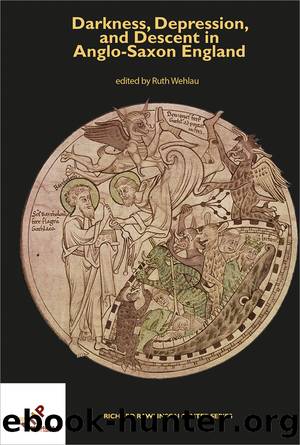Darkness, Depression, and Descent in Anglo-Saxon England by Ruth Wehlau;

Author:Ruth Wehlau;
Language: eng
Format: epub
Publisher: De Gruyter
Published: 2019-02-15T00:00:00+00:00
Chapter 7
The Fourth Fate of Men: Heremodâs Darkened Mind
James H. Morey
A BROAD INTERPRETATION OF THE causes of physical death applies as much to modern as to medieval bodies: one can succumb to sickness (adl), one can become subject to age (yldo), or one can die by violence (ecghete). Hrothgar enunciates these alternatives in lines 1735â1738 of his âsermonâ (lines 1700â1784 of Beowulf) and variations on the fates of human bodies appear in numerous elegiac poems such as the Exeter Bookâs Fortunes of Men. Similarly, the definition of mental death such that interpersonal and social relationships are impossible is as complex in Anglo-Saxon England as it is today. I wish to argue that, in addition to the three causes of physical death, there is a fourth, ambiguous category in the Anglo-Saxon imagination that describes a mode of death that today we would categorize as some kind of mental illness. It is designated most often by variations on the verb sweorcan, to grow dark. Hrothgar includes this fate among the others in lines 1735â1738, and I argue that it has been overlooked as a significant and pernicious human doom on a par with death by sickness, age, or violence. A darkened mind is not an emotional state or rhetorical figure, but is in fact a mode of death. I wish to connect this usage with other passages in Old English, notably in the Wanderer when the speaker âgeþencan ne mæg geond þas woruld / for hwan modsefa min ne gesweorceâ (âcannot think beyond this world why my mind should not darken,â 58â59).1 A darkened mind is the epic, heroic analogue to entering a monastery in a saintâs life or to being taken by fairies in a romance. The body lives, moves, and appears to function, but one is dead to this life. Mental death is as significant a category as bodily death, and Hrothgarâs inclusion of the category is far from casual or merely figurative. Heremod is, perhaps, the most memorable victim of the fourth fate of men, and Hrothgar cites him as the negative example of good kingship near the beginning of his sermon (lines 1709bâ1724a), just before he describes the four fates. Reading the sermon in the context of all four fates of men gives added significance to Hrothgarâs warnings of the inner demons Beowulf must resist, and it allows a glimpse into the notoriously various Anglo-Saxon understandings of the mind.2
The Indo-European root of sweorcan is *suord, Latin sordes (hence modern English sordid) and the word finds its way into a variety of Germanic languages. In Old English, adjectives and verbs build on the sweorc element. In a gloss to Aldhelmâs De Laudibus Virginitatis the word fuscatus (dark-colored, black) is glossed as âforsweorced,â and the word appears, variously spelled, in Middle English.3 It becomes, of course, modern German schwartz and modern English swarthy. More archaic forms are the adjective swart and the verb swerk, which is found in the OED. The literal meaning is straightforward: dark, dirty, base, or mean,
Download
This site does not store any files on its server. We only index and link to content provided by other sites. Please contact the content providers to delete copyright contents if any and email us, we'll remove relevant links or contents immediately.
Should I Stay or Should I Go? by Ramani Durvasula(7435)
Why We Sleep: Unlocking the Power of Sleep and Dreams by Matthew Walker(6362)
Fear by Osho(4496)
Flow by Mihaly Csikszentmihalyi(4493)
Rising Strong by Brene Brown(4195)
Why We Sleep by Matthew Walker(4193)
How to Change Your Mind by Michael Pollan(4115)
Too Much and Not the Mood by Durga Chew-Bose(4097)
The Hacking of the American Mind by Robert H. Lustig(4092)
Lost Connections by Johann Hari(3929)
He's Just Not That Into You by Greg Behrendt & Liz Tuccillo(3719)
Evolve Your Brain by Joe Dispenza(3506)
The Courage to Be Disliked by Ichiro Kishimi & Fumitake Koga(3264)
Crazy Is My Superpower by A.J. Mendez Brooks(3208)
What If This Were Enough? by Heather Havrilesky(3199)
Resisting Happiness by Matthew Kelly(3197)
Descartes' Error by Antonio Damasio(3167)
The Book of Human Emotions by Tiffany Watt Smith(3145)
In Cold Blood by Truman Capote(3140)
